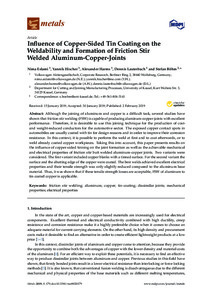Aufsatz

Influence of Copper-Sided Tin Coating on the Weldability and Formation of Friction Stir Welded Aluminum-Copper-Joints
Zusammenfassung
Although the joining of aluminum and copper is a difficult task, several studies have shown that friction stir welding (FSW) is capable of producing aluminum-copper-joints with excellent performance. Therefore, it is desirable to use this joining technique for the production of cost- and weight-reduced conductors for the automotive sector. The exposed copper contact spots in automobiles are usually coated with tin for design reasons and in order to improve their corrosion resistance. In this context, it is possible to perform the weld at first and to coat afterwards, or to weld already coated copper workpieces. Taking this into account, this paper presents results on the influence of copper-sided tinning on the joint formation as well as the achievable mechanical and electrical properties of friction stir butt welded aluminum-copper joints. Two variants were considered. The first variant included copper blanks with a tinned surface. For the second variant the surface and the abutting edge of the copper were coated. The best welds achieved excellent electrical properties and their tensile strength was only slightly reduced compared to the aluminum base material. Thus, it was shown that if these tensile strength losses are acceptable, FSW of aluminum to tin coated copper is applicable.
Zitierform
In: Metals 9 / 2 (2019-02-02) , S. 179 ; ISSN: 2075-4701Förderhinweis
Gefördert durch den Publikationsfonds der Universität KasselZitieren
@article{doi:10.17170/kobra-20190520488,
author={Eslami, Nima and Hischer, Yannik and Harms, Alexander and Lauterbach, Dennis and Böhm, Stefan},
title={Influence of Copper-Sided Tin Coating on the Weldability and Formation of Friction Stir Welded Aluminum-Copper-Joints},
journal={Metals},
year={2019}
}
0500 Oax 0501 Text $btxt$2rdacontent 0502 Computermedien $bc$2rdacarrier 1100 2019$n2019 1500 1/eng 2050 ##0##http://hdl.handle.net/123456789/11232 3000 Eslami, Nima 3010 Hischer, Yannik 3010 Harms, Alexander 3010 Lauterbach, Dennis 3010 Böhm, Stefan 4000 Influence of Copper-Sided Tin Coating on the Weldability and Formation of Friction Stir Welded Aluminum-Copper-Joints / Eslami, Nima 4030 4060 Online-Ressource 4085 ##0##=u http://nbn-resolving.de/http://hdl.handle.net/123456789/11232=x R 4204 \$dAufsatz 4170 7136 ##0##http://hdl.handle.net/123456789/11232
<resource xsi:schemaLocation="http://datacite.org/schema/kernel-2.2 http://schema.datacite.org/meta/kernel-2.2/metadata.xsd"> 2019-05-20T13:39:03Z 2019-05-20T13:39:03Z 2019-02-02 doi:10.17170/kobra-20190520488 http://hdl.handle.net/123456789/11232 Gefördert durch den Publikationsfonds der Universität Kassel eng Urheberrechtlich geschützt https://rightsstatements.org/page/InC/1.0/ friction stir welding aluminum copper tin-coating dissimilar joints mechanical properties electrical properties 620 Influence of Copper-Sided Tin Coating on the Weldability and Formation of Friction Stir Welded Aluminum-Copper-Joints Aufsatz Although the joining of aluminum and copper is a difficult task, several studies have shown that friction stir welding (FSW) is capable of producing aluminum-copper-joints with excellent performance. Therefore, it is desirable to use this joining technique for the production of cost- and weight-reduced conductors for the automotive sector. The exposed copper contact spots in automobiles are usually coated with tin for design reasons and in order to improve their corrosion resistance. In this context, it is possible to perform the weld at first and to coat afterwards, or to weld already coated copper workpieces. Taking this into account, this paper presents results on the influence of copper-sided tinning on the joint formation as well as the achievable mechanical and electrical properties of friction stir butt welded aluminum-copper joints. Two variants were considered. The first variant included copper blanks with a tinned surface. For the second variant the surface and the abutting edge of the copper were coated. The best welds achieved excellent electrical properties and their tensile strength was only slightly reduced compared to the aluminum base material. Thus, it was shown that if these tensile strength losses are acceptable, FSW of aluminum to tin coated copper is applicable. open access Eslami, Nima Hischer, Yannik Harms, Alexander Lauterbach, Dennis Böhm, Stefan doi:10.3390/met9020179 publishedVersion ISSN: 2075-4701 2 Metals 179 9 </resource>
Die folgenden Lizenzbestimmungen sind mit dieser Ressource verbunden:
Urheberrechtlich geschützt

